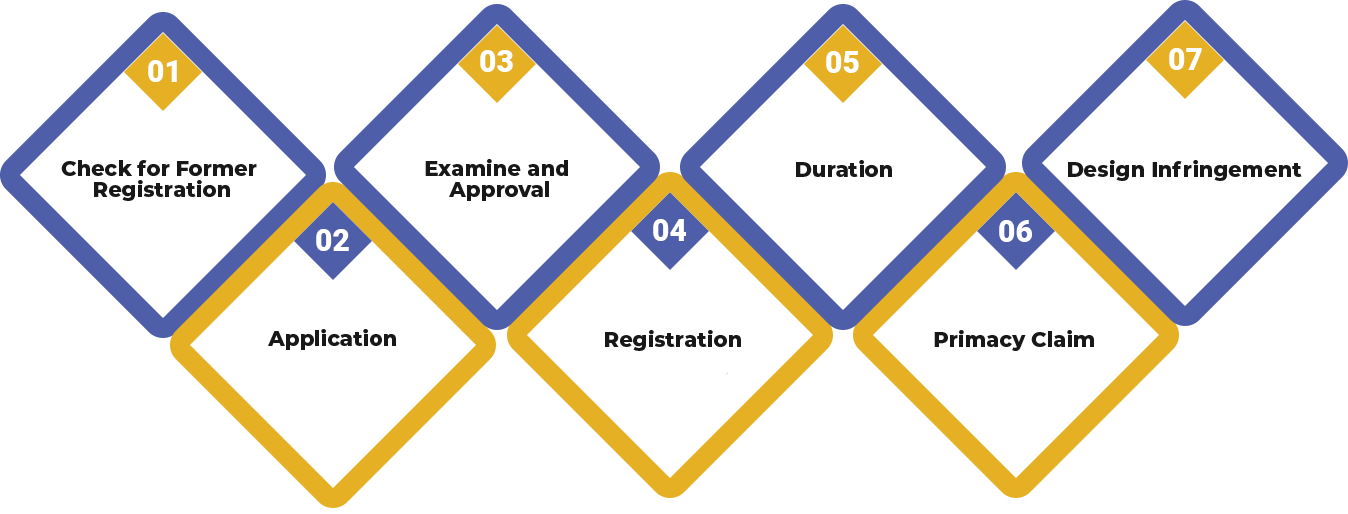An Overview of Design Registration
From May 11, 2001, the Designs Act, 2000 came into existence and the Design Rules, 2001 manage the Design Registration in India. As per the Designs Act, The Design Registration safeguards the features of ornamentation, configuration, pattern, composition, shape or colours applied to the articles. Since the registration of Design tries to safeguard the Design's visual appeal only, it doesn't comprise any possibility or feature that is a construction mode or an ordinary mechanical device or any artistic work that is protected under the Copyright Act or any trademark protected under the Trademarks Act.
Registration of a Design gives an exclusive right to its actual owner. This registration provides authority to the owner to use the Design for ten years; the time can be further extended for the next five years. In case of any violation, the design owner can look for legal help under the Design Act.
The application for Design registration should be filed with the Office of the Controller General of Patents, Trademarks and Designs at Kolkata under the Industry Policy Department and Promotion in the Ministry of Commerce and Industry. This office conducts an examination and then issue the registration certificate if the applicant is offered with adequate chance, comprising a hearing, to alter the application within the time limits that are permitted for validation for the requirements of the registration.
What is the Primary Purpose of Design Registration in India?
Registration of Design safeguards the copying of the product by complying with the Designs Act, 2000 at the office. As suggested in the Designs Act, a product's Design can be registered if it has an original and new pattern, shape, ornament, configuration or a specific combination is applied. For making a design suitable for the registration, it should be unique and new, which has been created through an industrial process.
The primary purpose of Design registration is to deliver the design creator or owner an exclusive right to exploit the Design and use it for commercial purposes. By simply filling an application for the registration doesn't promise Design Registration; the Registrar considers several aspects before allowing it. So, it is proposed to hire an expert in the process of filing an application for the registration, as they will make sure that the application is drafted in a correct manner.
Advantages of Design Registration in India
Following are some advantages that an owner can avail after getting registration of a design in India:
- A noble design makes any ornament or article engaging and attractive. Hence, it boosts the commercial value of Design, and it also boosts the product's marketability;
- It safeguards the visual traits of packaging or products. There is a number of companies that depend on Copyright and provide themselves with enough coverage. But, when any conflict arises, the other party will contest the copyright validity. Hence, Design Registration can be observed as the seamless alternative to prove the validity of certain rights;
- In case the Design is safeguarded, the author or creator or owner of the Design has an exclusive right to sue the person or any third party who are copying the Design for their benefits. This guarantees that the product's Design is genuine and unique and is exclusive to the creator;
- When the owner of a design adds something creative to their product, it adds some individual character to the Design. The originality has its own tactic in the market which helps the new product informing its own place between all present products.
Eligibility Criteria for Design Registration in India
To register a design and safeguarded under the Design Act, 2000, it is mandatory to fulfil the following criteria:
- The Design should not contain any artistic works, trademarks, or property marks;
- The basic of the Design is the features that are signified by the patterns, ornamentation, shapes, configuration, a composition that applies to an article;
- The Design should be original and unique or not previously published in any nation before the date of application of Design Registration;
- The designs not only appreciated with the eyes. The process of creation and application is completely irrelevant;
- There should be a major difference between your designs and other designs that have already been registered. Similar designs, even if it is somewhat different doesn’t qualify to be registered.
What are the Different Features of Design Registration?

- Protection
The Patent Office makes a list of all the designs which are registered. The primary objective of creating the list is to aware competitors regarding the registration and hence protects them from counterfeiting. In case of any infringement, the owner has the right to take some legal action under the Design Act.
- File Skillfully
It is vital to file expertly for the registration of a design since it is the easiest method to make sure that the Design is safeguarded properly. With the support of professional like Swarit Advisors, help in the process of Design Registration by filing an application and addressing all the aspects of the Design Act.
- Government Procedure
The registration of a design is a somewhat boring process that is only completed by the Registrar. Registrar goes through the premises and the facts of each case. So, with the help of experts, it is easy to file for the registration application. The expertise, knowledge, and experience of the experts make the process simple.
- Timeline
After filing the application for Design Registration, it becomes your responsibility to keep a check on the application status. The application of Design Registration often goes through various time-bound reply or action from the applicant.
Essential Documents Required for Design Registration in India
Below is the list of all the crucial documents required for Design Registration:
- Submit a duly certified copy of original or certified copies of the extracts from all disclaimers;
- Proper Declarations;
- All Affidavits;
- Any other documents can be made available on the fee payment.
You should make sure to file the affidavit in paragraph form. It must include a declaration of truth and verifiability. As per the 4th schedule, the controller regulates the costs involved in the registration process.
What is the Procedure of Design Registration?
Finishing the Design is the first step towards product achievement for any organization. A vast measure of assets and time is spent making plans that show up in the marketplace and take the customer's attention. Organizations might want such plan rights to be secured with the goal that their valuable ideas are not taken by any 3rd party.
The office of the administration responsible for the registration of the mechanical plan is the Office of the Controller General of Patents, Trademarks, and Designs. Registration and safeguarding recent plans in India are directed by the Designs Act, 2000.
The lawful meaning of "Design" indicates the highlights, for example, pattern, colour, shape, configuration, or colour or a mix applied to any product or an article by any mechanical procedure, which in the completed article pleas to the eye. It does eliminate any rule of development or any trademark, property or creative mark. The structure should be new or unique and must not have been distributed in any country prior to the date of the registration application.
Following is the process of Design Registration:

- Check for Former Registration
The first step is to check if you have registered your Design in the previous. For that, you need to file an application to the Office of the Patent. It is good of you to register your designs as soon as possible because the system works on the basis of the first-to-file rule.
- Application
Then, you need to write an application for the registration and provide the information such as full name and address, whether you are an individual or an entity, detail about the article and its class, etc.
- Examine and Approval
Once you fill and submit the application, then the Patent Office inspects it. If it's all together, it gets registered and approved, and later, the Registration Certificate is issued to the applicant or the owner. After the planned recording, the article, along with other bibliographic information, gets advised in the Patent Journal Office, distributed. The complete thought could take around a year in the complications event.
- Registration
Once your Design is completely registered, it makes an entry into the Registrar; it's a document that Patent Office maintains. It consists of the design number, class number, filing date, name, and address of the owner.
- Duration
The validity of Design Registration is up to ten years, and further, it can be extended for the next five years.
- Primacy Claim
India is one of the participants of the Paris Convention, so the arrangements for the privilege of need are relevant. This case allows you to file another application in a different country for alike or Trademark, significant as of the date of filing the primary application.
- Design Infringement
In case of any design infringement or violation, the owner of a registered design has the power to take some lawful action to stop misuse and to claim any damage. The lawbreaker has to pay Rs. 25,000/- for any damage caused by the lawbreaker.
Fine for the Piracy of Registered Design
On occasion, if someone challenges the Copyright in a design, he or she is subjected for each offence to pay Rs. 25,000/- to the registered owner subject to a limit of Rs. 50,000/- recoverable as agreement obligation in respect to one plan. The registered owner may bring a suit for the recovery of the damages for any such negation and order against the equivalent's dismissal. Total recoverable will not exceed Rs. 50,000/- as agreement duty as stated in Section 22(2)(a). The suit for infringement, recovery of harm and so forth must not be recorded in any court under the court of District Judge.
Comparison between Design Registration and Trademark Registration
1. Definition:
- Trademark
It works as a name, logo, symbol, or word of your trade. Trademark Registration safeguards such logo, word, symbol from infringement such as copying, misusing, and selling without permission from the actual owner of the registered Trademark.
- Design
A design is a diagrammatic representation, which is done to protect the designs.
2. Innovation:
- Trademark
A Trademark is in the form of a word, logo, or mark, and it is not important to keep the brand innovative.
- Design
A design is more than an illustration, so it is essential to make the Design more innovative and distinct.
3. Protection:
- Trademark
It's the image of a business that it represents. The looks of a Trademark is depended on the aspect of what a Trademark is about. The protection of a Trademark is given so that no other entity will use the similar mark, and in case of any Trademark violation, the owner of a registered Trademark has the authority to sue the company.
- Design
Design Registration protects the product, and it covers all the product's factors; that is, how it appears and what it does.
4. Protection Act:
- Trademark
The Trademark Act, 1999 safeguards the Trademark, and it can be presented realistically and is enough to distinguish the goods & services of a single individual from another person can be considered for registration.
- Design
Design Act, 2000 safeguards the Design. According to this Act, things like ornament, configuration, shape, composition of lines or combination used in Design is registered.
Frequently Asked Questions
A design is stated to the pattern, shape, combination of colour or lines, ornament, etc. of the product, which can be seen with eyes. It doesn't comprise any way that is used to make the Design. Designs can be 2-d or 3-d.
A Trademark is a type of IPR (Intellectual Property Right) comprising a recognizable logo, name, sign, Design or phrase which identifies the products of a company.
The ownership of a registered design can be transferred in the following ways:
- Assignment;
- Transmission;
- License Agreement.
The validity of Design registration is of 10 years, and after then years, it can be extended for five years.
- The owner of any design;
- An assignee (either individually or jointly);
- In the case of NRI, their legal representative.
The meaning of an article under the Designs Act, 2000 is that any article of manufacture and any artificial/partly artificial, substance, and partly natural; and consist any article part capable of being made and sold separately.
The primary objective of Design registration is to deliver the design creator or owner an exclusive right to exploit the Design and use it for commercial purposes.
No, an already registered design, the Copyright of which has deceased cannot be registered again.
If someone contravenes the Copyright in a design, he or she is subjected for each offence to pay Rs. 25,000/- to the registered owner subject to a limit of Rs. 50,000/- recoverable as agreement obligation in respect to one plan.
It is the property that has been formed by the implementation of Intellectual Faculty. IPR permit the owners/creators to have the benefits from their original work when these are misused commercially. These rights refer to the mind's creation, such as invention, artistic works, symbols, designs, literature, etc., which are eventually used in commerce.


